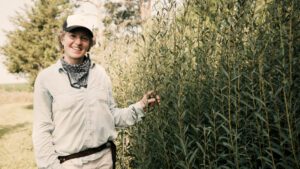“I hope that this inspires you to incorporate perennials into your own farm operation,” Maggie Taylor, Delight Flower Farm

Maggie Taylor, owner of Delight Flower Farm, grew up with a mom and grandpa who were avid gardeners. As a kid, her chores were weeding and mulching. “I hated it actually,” says Maggie.
As an adult, she studied library science and was a reference librarian. But sitting in front of a computer made Maggie feel called to be outside and to be in nature with the seasons. She started growing a personal garden and then eventually started a small CSA. The demand for flowers really grew and the business idea organically grew right along with it.
Maggie is one of the farmers who have worked with the Savanna Institute to apply for and receive support from the USDA to add more perennials to her flower operation. Most of the perennials are part of an alley cropping system that alternate flowers and elderberry, a woody perennial that thrives in Central Illinois. Woody perennials can do a lot for the environment: creating habitat, sequestering carbon, and reducing tillage.
“Those are all things that you can feel good about doing,” Maggie says. “As a business, in terms of a production farm, there’s also some advantages because once you plant them, you don’t have to plant them again. You cut out the labor on an annual basis when you’re planting perennials. You still have the labor of cutting and harvesting them once they start to be at an age in which they’re producing something usable.”
The foliage and flowers from the elderberries can be used as ornamentals for customer bouquets while the deep roots sequester carbon and take care of the soil health for the farm system. Planted only two years ago, Maggie’s team has already started harvesting the elderberries to use them in herbal bath and beauty products to generate income in the winter months.
Providing habitat for birds adds birdsong to the farm, and also acts as a pest deterrent. “A lot of our pests on our flower crops are insects, and birds love to eat insects. It’s their food. So it’s creating a balance in the ecosystem that supports reduced use of pesticides.”

